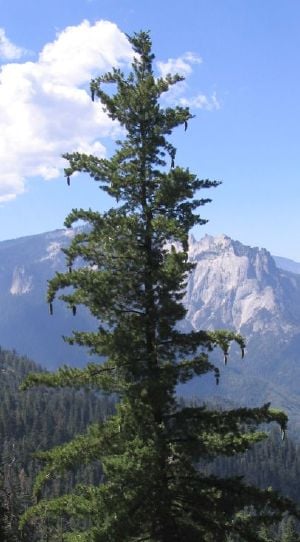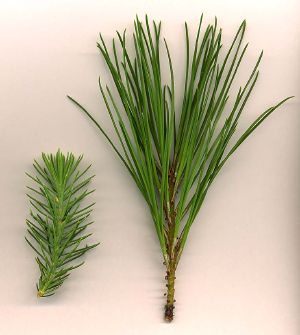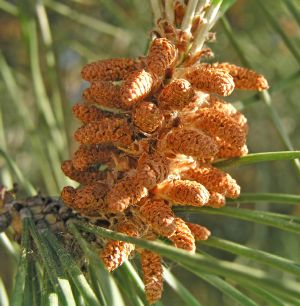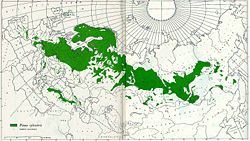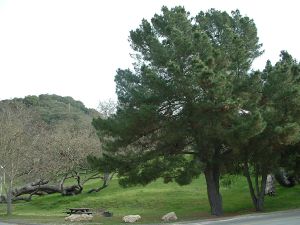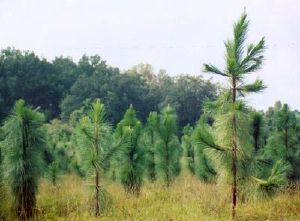Pine
| Pines | ||||||||||||
|---|---|---|---|---|---|---|---|---|---|---|---|---|
Sugar Pine (Pinus lambertiana) | ||||||||||||
| Scientific classification | ||||||||||||
| ||||||||||||
| Species | ||||||||||||
|
About 115. |
Pines are coniferous trees of the genus Pinus, in the family Pinaceae. There are about 115 species of pine, although different authors accept anything from 105 to 125 species.
Distribution
Pines are native to most of the Northern Hemisphere. In North America, they range from the Arctic south to Nicaragua and Hispaniola, with the highest diversity in Mexico and California. In Eurasia, they range from Portugal and Scotland east to the Russian Far East, Japan, and the Philippines, and south to northernmost Africa, the Himalaya and Southeast Asia, with one species (Sumatran Pine) just crossing the Equator in Sumatra. Pines are also extensively planted in many parts of the Southern Hemisphere.
Morphology
Pines are evergreen and resinous. The bark of most pines is thick and scaly, but some species have thin, flaking bark. The branches are produced in regular "pseudowhorls", actually a very tight spiral but appearing like a ring of branches arising from the same point. Many pines are uninodal, producing just one such whorl of branches each year, from buds at the tip of the year's new shoot, but others are multinodal, producing two or more whorls of branches per year. The spiral growth of branches, needles and cone scales are arranged in Fibonacci number ratios. The new spring shoots are sometimes called "candles"; they are light-colored and point upward at first, then later darken and spread outward. These "candles" offer foresters a means to evaluate fertility of the soil and vigour of the trees.
Foliage
Pines have four types of leaves. Seedlings begin with
- a whorl of 4-20 seed leaves (cotyledons), followed immediately by
- juvenile leaves on young plants, 2-6 cm long, single, green or often blue-green, and arranged spirally on the shoot. These are replaced after six months to five years by
- scale leaves, similar to bud scales, small, brown and non-photosynthetic, and arranged like the juvenile leaves; and
- the adult leaves or needles, green (photosynthetic), bundled in clusters (fascicles) of (1-) 2-5 (-6) needles together, each fascicle produced from a small bud on a dwarf shoot in the axil of a scale leaf. These bud scales often remain on the fascicle as a basal sheath. The needles persist for 1.5-40 years, depending on species. If a shoot is damaged (e.g. eaten by an animal), the needle fascicles just below the damage will generate a bud which can then replace the lost growth.
Cones
Pines are mostly monoecious, having the male and female cones on the same tree, though a few species are sub-dioecious with individuals predominantly, but not wholly, single-sex. The male cones are small, typically 1-5 cm long, and only present for a short period (usually in spring, though autumn in a few pines), falling as soon as they have shed their pollen. The female cones take 1.5-3 years (depending on species) to mature after pollination, with actual fertilization delayed one year. At maturity the cones are 3-60 cm long. Each cone has numerous spirally arranged scales, with two seeds on each fertile scale; the scales at the base and tip of the cone are small and sterile, without seeds. The seeds are mostly small and winged, and are anemophilous (wind-dispersed), but some are larger and have only a vestigial wing, and are bird-dispersed (see below). At maturity, the cones usually open to release the seeds, but in some of the bird-dispersed species (e.g. Whitebark Pine), the seeds are only released by the bird breaking the cones open. In others, the fire climax pines (e.g. Monterey Pine, Pond Pine), the seeds are stored in closed ("serotinous") cones for many years until a forest fire kills the parent tree; the cones are also opened by the heat and the stored seeds are then released in huge numbers to re-populate the burnt ground.
Ecology
Pines grow well in acid soils, some also on calcareous soils; most require good soil drainage, preferring sandy soils, but a few, e.g. Lodgepole Pine, will tolerate poorly drained wet soils. A few are able to sprout after forest fires, e.g. Canary Island Pine. Some species of pines, e.g. Bishop Pine, need fire to regenerate and their populations slowly decline under fire suppression regimes. Several species are adapted to extreme conditions imposed by elevation and latitude; see e.g. Siberian Dwarf Pine, Mountain Pine, Whitebark Pine and the bristlecone pines. The pinyon pines and a number of others, notably Turkish Pine, are particularly well adapted to growth in hot, dry semi-desert climates.
The seeds are commonly eaten by birds and squirrels. Some birds, notably the Spotted Nutcracker, Clark's Nutcracker and Pinyon Jay, are of importance in distributing pine seeds to new areas where they can grow. Pine needles are sometimes eaten by some Lepidoptera species (see list of Lepidoptera which feed on Pines) and also the Symphytan species Pine Sawfly.
Classification of Pines

Pines are divided into three subgenera, based on cone, seed and leaf characters:
- Subgenus Strobus (white or soft pines). Cone scale without a sealing band. Umbo terminal. Seedwings adnate. One fibrovascular bundle per leaf.
- Subgenus Ducampopinus (pinyon, lacebark and bristlecone pines). Cone scale without a sealing band. Umbo dorsal. Seedwings articulate. One fibrovascular bundle per leaf.
- Subgenus Pinus (yellow or hard pines). Cone scale with a sealing band. Umbo dorsal. Seedwings articulate. Two fibrovascular bundles per leaf.
File:Pinecandle9872.jpg Young spring growth ("candles") on a Loblolly Pine |
File:Pine cone edit.jpg Monterey Pine cone on forest floor |
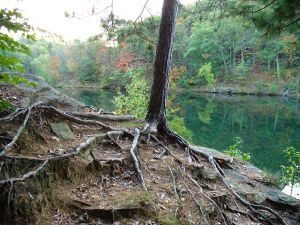 A red pine (Pinus resinosa) clearly displaying its roots |
File:Pinien La Brena2004.jpg Mature Pinus pinea (Stone Pine)- note umbrella-shaped canopy |
File:WhitebarkPine 7467t.jpg Whitebark Pine in the Sierra Nevada |
File:Sierra Madre.jpg Hartweg's Pine forest in Mexico |
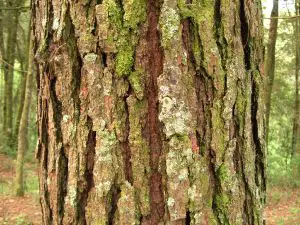 The bark of a pine in Tecpan, Guatemala. |
File:Pine needles volcanoes guatemala.jpg A pine, probably P. apulcensis, in Guatemala. |
Some important pine species
Pinus pinea - Stone Pine
The Stone Pine (Pinus pinea) is native of southern Europe, primarily the Iberian Peninsula. It has been exploited for its edible pine nuts since prehistoric times. Currently, it is also a widespread horticultural tree, besides being cultivated for the seeds.
The Stone Pine can exceed 25 m height, though is usually rather less tall, 12-20 m being more normal. It has a very characteristic shape, with a short trunk and very broad, smoothly rounded to nearly flat crown. The bark is thick, red-brown and deeply fissured into broad vertical plates. The flexible mid-green leaves are needle-like, in bundles of two, and are 10-20 cm long (exceptionally up to 30 cm). Young trees up to 5-10 years old bear juvenile leaves, which are very different, single (not paired), 2-4 cm long, glaucous blue-green; the adult leaves appear mixed with juvenile leaves from the fourth or fifth year on, replacing it fully by around the 10th year. Juvenile leaves are also produced in re-growth following injury, such as a broken shoot, on older trees.
The cones are broad ovoid, 8-15 cm long, and take 36 months to mature, longer than any other pine. The seeds (pine nuts, piñones or pinoli) are large, 2 cm long, pale brown with a powdery black coating which rubs off easily, and have a rudimentary 4-8 mm wing which falls off very easily. The wing is ineffective for wind dispersal, and the seeds are animal-dispersed, originally mainly by the Azure-winged Magpie, but in recent history, very largely by Humans.
The original range Stone Pine was probably only in Portugal and Spain, but it has been cultivated extensively for at least 6,000 years for the edible seeds. These have been trade items since early historic times. It is cultivated and often naturalised throughout the Mediterranean region, for so long that it is often considered native, while more recently (since about 1700) been introduced to other areas with Mediterranean climates. It is now naturalised in South Africa (where it is listed as an invasive species) and commonly planted in California, Australia, and western Europe north to southern Scotland. Small specimens are grown in large planters or are used for Bonsai, and year-old seedlings are also widely sold as 20-30 cm tall table-top christmas trees.
The Stone Pine has also been called Italian Stone Pine, European Nut Pine, Umbrella Pine (not to be confused with the Japanese Umbrella-pine) and Parasol Pine. It has also occasionally been listed under the invalid name Pinus sativa.
Pinus sylvestris - Scots Pine
The Scots Pine (Pinus sylvestris L.; family Pinaceae) is a common tree ranging from Great Britain and Spain east to eastern Siberia and the Caucasus Mountains, and as far north as Lapland. In the north of its range, it occurs from sea level to 1000 m, while in the south of its range, it is a high altitude mountain tree, growing at 1200-2500 m altitude.
In the British Isles it is now native only in Scotland, but historical records indicate that it also occurred in Ireland, Wales and England as well until about 300-400 years ago, becoming extinct here due to over-exploitation; it has been re-introduced in these countries. Similar historical extinction and re-introduction applies to Denmark and the Netherlands.
It grows up to 25m in height when mature, exceptionally to 35-40m on a very productive site. The bark is thick, scaly dark grey-brown on the lower trunk, and thin, flaky and orange on the upper trunk and branches. The habit of the mature tree is distinctive due to its long, bare and straight trunk topped by a rounded or flat-topped mass of foliage.
On mature trees the leaves ('needles') are a very attractive blue-green, 3-5 cm long and occur in pairs, but on young vigorous trees the leaves can be twice as long, and occasionally occur in threes and fours on the tips of strong shoots. The cones are pointed ovoid in shape and are 3-7 cm in length.
Over 100 varieties have been described in the botanical literature, but only three are now accepted, the typical var. sylvestris from Scotland and Spain to central Siberia, var. hamata in the Balkans, northern Turkey and the Caucasus, and var. mongolica in Mongolia and adjoining parts of southern Siberia and northwestern China. One other variety, var. nevadensis in southern Spain, may also be distinct.
Scots Pine is the only pine native to northern Europe, forming either pure forests or alongside Norway Spruce, Silver Birch, Common Rowan, Eurasian Aspen and other hardwood species. In central and southern Europe, it occurs with numerous additional species, including European Black Pine, Mountain Pine, Macedonian Pine and Swiss Pine. In the eastern part of its range, it also occurs with Siberian Pine among other trees.
Scots Pine is the National tree of Scotland, and it formed much of the Caledonian Forest which once covered much of the Scottish Highlands. Overcutting for timber demand, fire, overgrazing by sheep and deer, and even deliberate clearance to deter wolves have all been factors in the decline of this once great pine and birch forest. Nowadays only comparatively small areas of this ancient forest remain, the main surviving remnants being Glen Affric, Rothiemurchus, and the Black Wood of Rannoch. Plans are currently in progress to restore at least some areas and work has started at key sites.
The wood is pale brown to red-brown, and used for general construction work. It has a dry density of around 470 kg/m3 (varying with growth conditions), an open porosity of 60%, a fibre saturation point of 0.25 kg/kg and a saturation moisture content of 1.60 kg/kg.
Scots Pine has also been widely planted in New Zealand and much of the colder regions of North America; it is listed as an invasive species in some areas there, including Ontario and Wisconsin.
Pinus densiflora - Japanese Red Pine
The Japanese Red Pine (Pinus densiflora) has a home range that includes Japan, Korea, northeastern China and the extreme southeast of Russia. It has become a popular ornamental and has several cultivars. The height of this tree is 20-35 m. The Japanese red pine prefers full sun on well-drained, slightly acidic soil.
The leaves are needle-like, 8-12 cm long, with two per fascicle. The cones are 4-7 cm long. It is closely related to Scots Pine, differing in the longer, slenderer leaves which are mid green without the glaucous-blue tone of Scots Pine.
In Japan it is known as Akamatsu and Mematsu. It is widely cultivated in Japan both for timber production and as an ornamental tree, and plays an important part in the classic Japanese garden.
Pinus lambertiana - Sugar Pine
The Sugar Pine (Pinus lambertiana) occurs in the mountains of Oregon and California in the western United States, and Baja California in northwestern Mexico; specifically the Sierra Nevada, the Cascade Range, the Coast Ranges, and the Sierra San Pedro Martir.
The Sugar Pine is the largest species of pine, commonly growing to 40-60 m tall, exceptionally up to 81 m tall, and with a trunk diameter of 1.5-2.5 m, exceptionally 3.5 m. It is also notable for having the longest cones of any conifer, mostly 25-50 cm long, exceptionally up to 66 cm long.
The Sugar Pine has been severely affected by the White Pine Blister Rust (Cronartium ribicola), a fungus that was accidentally introduced from Europe in 1909. A high proportion of the Sugar Pine has been killed by the blister rust, particularly in the northern part of the species' range (further south in central and southern California, the summers are too dry for the disease to spread easily). The rust has also destroyed much of the Western White Pine and Whitebark Pine outside of California. The US Forest Service has a program for developing rust-resistant Sugar Pine and Western White Pine. Seedlings of these trees have been introduced into the wild.
Pinus longaeva - Great Basin Bristlecone Pine
Pinus ponderosa - Ponderosa Pine
Pinus radiata - Monterey Pine or Radiata Pine
|
Uses
Pines are commercially among the most important of species used for timber in temperate and tropical regions of the world. Many are grown as a source of wood pulp for paper manufacture. This is because they are fast-growing softwoods that can be planted in relatively dense stands, and because their acidic decaying needles may inhibit the growth of other competing plants in the cropping areas. A typical example is Pinus radiata. The resin of some species is important as the source of turpentine. Some species have large seeds, called pine nuts, that are harvested and sold for cooking and baking. Some pines are used for Christmas trees, and pine cones are also widely used for Christmas decorations. Many pines are also very attractive ornamental trees planted in parks and large gardens. A large number of dwarf cultivars have been selected, suitable for planting in smaller gardens.
Pine plantations can be at risk of fire damage because pine resin is flammable to the point of a tree being explosive under some conditions.
Pine trees are also famous for their pleasant smell, but some people find the smell overbearing. A very small number of people are allergic to pine resin and its scent can trigger an asthma attack. What makes this particularly unusual is that it is also a treatment for asthma in some forms of alternative medicine.
Nutritional use
Pines are well-known survival food plants. The soft, moist, white inner bark, or cambium, found clinging to the dead, woody outer bark is edible and very high in vitamins A and C. It can be eaten in slices raw as a snack or dried and ground up into a powder for use as a thickener/flavoring in stews, soups, and other foods. The bunches of young green cones found at the ends of branches make a healthy hiking snack. A tea made by steeping young, green pine needles in boiling water (known as "strunt" in Sweden) is high in vitamins A and C.
ReferencesISBN links support NWE through referral fees
- Dallimore, W. & Jackson, A.B. revised by Harrison, S.G., 1967, A Handbook of Coniferae and Ginkgoaceae, New York : St. Martin's Press
- Earle, C.J., 2006, The Gymnosperm Database, Website[1]
- Farjon, A. 1984, 2nd edition 2005. Pines. E. J. Brill, Leiden. ISBN 90-04-13916-8
- Lanner, R.M., 1999, Conifers of California,Los Alivos, California : Cachuma Press ISBN 0962850535
- Little, E. L., Jr., and Critchfield, W. B. 1969. Subdivisions of the Genus Pinus (Pines). US Department of Agriculture Misc. Publ. 1144 (Superintendent of Documents Number: A 1.38:1144).
- The Lovett Pinetum Charitable Foundation, 2006, Website [2]
- Miller, L., 2006, The Ancient Bristlecone Pine, Website [3]
- Mirov, N. T. 1967. The Genus Pinus. Ronald Press, New York (out of print).
- Peterson, R., 1980, The Pine Tree Book, New York : The Brandywine Press ISBN 0896160068
- Richardson, D. M. (ed.). 1998. Ecology and Biogeography of Pinus. Cambridge University Press, Cambridge. 530 p. ISBN 0-521-55176-5
External links
- Classification of pines
- Arboretum de Villardebelle Images of cones of selected species
- Gymnosperm Database - Pinus
- Gymnosperm families - scroll down to the Pinaceae
| Links to other Pinaceae genera |
| Pinus | Picea | Cathaya | Larix | Pseudotsuga | Abies | Cedrus | Keteleeria | Pseudolarix | Nothotsuga | Tsuga |
Credits
New World Encyclopedia writers and editors rewrote and completed the Wikipedia article in accordance with New World Encyclopedia standards. This article abides by terms of the Creative Commons CC-by-sa 3.0 License (CC-by-sa), which may be used and disseminated with proper attribution. Credit is due under the terms of this license that can reference both the New World Encyclopedia contributors and the selfless volunteer contributors of the Wikimedia Foundation. To cite this article click here for a list of acceptable citing formats.The history of earlier contributions by wikipedians is accessible to researchers here:
The history of this article since it was imported to New World Encyclopedia:
Note: Some restrictions may apply to use of individual images which are separately licensed.
